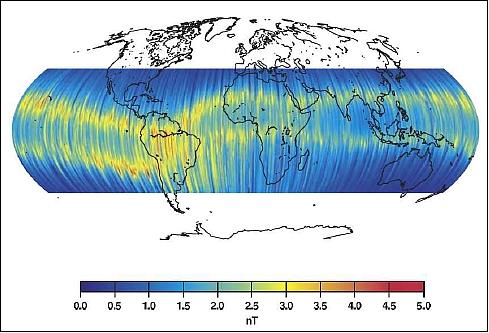NanoSatC-Br1 is the first CubeSat project of Brazil, developed at the Southern Regional Space Research Center (CRS/CCR/INPE-MCT) in collaboration with the Space Science Laboratory of the Federal University of Santa Maria (LACESM/CT – UFSM), Santa Maria, RS, Brazil. The INPE (Instituto de Pesquisas Espaciais) South Regional Center is in fact located on the campus of UFSM (Federal University of Santa Maria) and collaboration between the two institutions is of importance for mission success. The mission has three objectives in the fields of science, technology validation, and academic i.e., student involvement in all mission phases.
The CubeSat project is considered to be a capacity building mission with the goal to involve a new generation of scientists and engineering students through a CubeSat program, providing hands-on training and learning dealing with aerospace technologies and space weather issues. The NanoSatC-BR project made it possible to involve Brazilian universities, such as UFSM (Federal University of Santa Maria), in the Brazilian Space Program with a collaboration of INPE. CRS acts as the NanoSatC-BR1 mission general manager and PI in collaboration with INPE.
The objective of the mission is to provide monitoring of Earth’s magnetosphere by measuring the magnetic field over Brazil and to study the magnetic phenomena of the SAA (South Atlantic Anomaly) and the EEJ (Equatorial Electrojet). Note: This SAA is also referred to as SAMA (South Atlantic Magnetic Anomaly).
• One feature of particular interest is the South Atlantic Anomaly (SAA), an area where the radiation hazard from high proton fluxes and cosmic rays is high due to the relatively low shielding effect provided by the Earth’s magnetic field. In this area, for example, a significantly higher number of so-called SEUs (Single Event Upsets) occur in LEO (Low Earth Orbiting) satellites (Heirtzler, 2002, Figure 1).
Figure 1: Magnetic field intensity, year 2000, where the 28000nT isopleth shows the SAA region (NASA/GSFC)
• The EEJ (Equatorial Electrojet) is a narrow ribbon of current flowing eastward in the day time equatorial region of the Earth’s ionosphere. The abnormally large amplitude of variations in the horizontal components measured at equatorial geomagnetic observatories, as a result of EEJ, was noticed as early as 1920 from ground observations. The EEJ phenomenon was first identified using geomagnetic data. The amplitude of the daily variation of the horizontal magnetic intensity (ΔH) measured at a geomagnetic observatory near the dip-equator is 3–5 fold higher than the variation of data from other regions of Earth. A typical diurnal equatorial observatory data show a peak of strength ~80 nT at 12:00 hours LT (Local Time), with respect to the night-time level.
EEJ studies from satellite data were initiated with the arrival of data from the POGO (Polar Orbiting Geophysical Observatories) series of satellite (1967–1970). The characteristic signature of the EEJ is a sharp negative V-shaped curve in the ΔH field, attaining its minimum within 0.5º of the magnetic dip equator. The magnetic data from satellite missions like Ørsted (1999–present) and CHAMP (2000–2010) have vastly improved our knowledge of the EEJ (Figure 2
).
Figure 2: Ionosphere Equatorial Electrojet representation (image credit: GFZ)
The NanoSatC-BR1 concept was developed to:
• monitor, in real-time the geospace, the particle precipitation and the disturbances at the Earth’s magnetosphere over the Brazilian territory
• determine their effects on regions such as the South Atlantic Magnetic Anomaly (SAMA).






